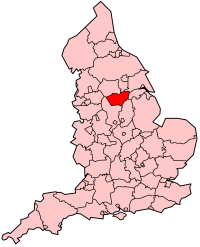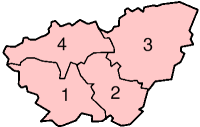South Yorkshire
 |
|
| Geography | |
| Status | Ceremonial and Metropolitan county (no county council) |
|---|---|
| Origin | 1974 |
| Region | Yorkshire and the Humber |
| Historic county | Yorkshire (West Riding) |
| Area - Total |
Ranked 38th 1,552 km2 (599 sq mi) |
| ONS code | 2C |
| NUTS 3 | UKE3 |
| Demographics | |
| Population - Total (2007 est.) - Density |
Ranked 10th 1,299,400 838 / km² |
| Ethnicity | 95.0% White 2.6% S.Asian 2.4% Black |
| Politics | |
| Members of Parliament | |
| Districts | |

|
|
South Yorkshire is a metropolitan county, located in the Yorkshire and the Humber region of England. The county was created in 1974 by the Local Government Act 1972[1] and in 2001 covered an area of 1,552.05 km2 (599.25 sq mi).[2]
Contents |
Divisions and environs
South Yorkshire is divided into four local government districts; they are the City of Sheffield, the Metropolitan Borough of Doncaster, the Metropolitan Borough of Barnsley and the Metropolitan Borough of Rotherham.[3]
Geography
The county borders Derbyshire, West Yorkshire, North Yorkshire, East Riding of Yorkshire, Lincolnshire and Nottinghamshire. The metropolitan county lies largely on the carboniferous rocks of the Yorkshire coalfield which have produced a rolling landscape with hills, escarpments and broad valleys. In this landscape there is widespread evidence of both current and former industrial activity. There are numerous mine buildings, former spoil heaps and iron and steel plants. The scenery is a mixture of built up areas, industrial land with some dereliction, and farmed open country. Ribbon developments along transport routes including canal, road and rail are prominent features of the area although some remnants of the pre industrial landscape and semi-natural vegetation still survive.[4]
Major rivers which cross the area are the Dearne, Rother and Don. To the east, in the Doncaster area the landscape becomes flatter as the eastward dipping carboniferous rocks of the coalfield are overlain by the lacustrine deposits of the Humberhead Levels.[5] There is very little evidence of glaciation in the area as it lies largely beyond the limit of the last glaciation.
History
The main settlements of South Yorkshire grew up around the industries of mining and steel manufacturing. The main mining industry was coal which was concentrated to the north and east of the county. There were also iron deposits which were mined in the area. The rivers running off the Pennines to the west of the county supported the steel industry that is concentrated in the city of Sheffield. The proximity of the iron and coal also made this an ideal place for steel manufacture.
Although Christian nonconformism was never as strong in South Yorkshire as in the mill towns of West Yorkshire, there are still many Methodist and Baptist churches in the area. Also, South Yorkshire has a relatively high number of followers of spiritualism. It is the only county that counts as a full region in the Spiritualists' National Union.[6]
South Yorkshire was created as a metropolitan county in 1974, by the Local Government Act 1972, from the southern part of the West Riding of Yorkshire and the former county boroughs of Barnsley, Doncaster, Rotherham and Sheffield. It initially had a two tier structure of local government with a strategic-level county council and four districts providing most services.[7]
In 1974, as part of the South Yorkshire Structure Plan of the environment, conservation and land use, South Yorkshire County Council commissioned a public attitudes survey covering job opportunities, educational facilities, leisure opportunities, health and medical services, shopping centres and transport in the county.[8]
In 1986, throughout England the metropolitan county councils were abolished. The functions of the county council were devolved to the boroughs; joint-boards covering fire, police and public transport; and to other special joint arrangements.[9] The joint boards continue to function and include the South Yorkshire Police Authority and the South Yorkshire Passenger Transport Executive.[10]
Although the county council was abolished, South Yorkshire remains a metropolitan and ceremonial county with a Lord Lieutenant of South Yorkshire and a High Sheriff.
Economy
As one of the least prosperous areas in Western Europe, South Yorkshire has been targeted for funding from the European Regional Development Fund. This is a chart of trend of regional gross value added of South Yorkshire at current basic prices with figures in millions of British Pounds Sterling.[11]
| Year | Regional Gross Value Added[12] | Agriculture[13] | Industry[14] | Services[15] |
|---|---|---|---|---|
| 1995 | 10,453 | 67 | 3,690 | 6,696 |
| 2000 | 13,187 | 53 | 4,181 | 8,954 |
| 2003 | 15,799 | 57 | 4,772 | 10,971 |
Settlements
- See also: List of civil parishes in South Yorkshire
The table below outlines many of the county's settlements, and is formatted according to their metropolitan borough.
| Metropolitan county | Metropolitan borough | Centre of administration | Other places | |
|---|---|---|---|---|
| South Yorkshire | Barnsley (borough) | Barnsley (town) | Birdwell, Cudworth, Darfield, Darton, Dodworth, Great Houghton, Grimethorpe, Hoyland Nether, Royston, Penistone, Thurnscoe, Wombwell, Worsbrough | |
| Doncaster (borough) | Doncaster (town) | Adwick le Street, Armthorpe, Askern, Bawtry, Bentley, Conisbrough, Finningley, Hatfield, Kirk Sandall, Mexborough, Moorends, Stainforth, Rossington, Norton, Thorne, Tickhill, | ||
| Rotherham (borough) | Rotherham (town) | Anston, Aughton, Dinnington, Harthill, Maltby, Rawmarsh, Scholes, Swinton, Thorpe Hesley, Todwick, Treeton, Thurcroft, Wales, Wath-upon-Dearne, Woodsetts | ||
| City of Sheffield | Sheffield City Centre | Beighton, Chapeltown, Highlane, Mosborough, Oughtibridge, Stocksbridge, Wharncliffe Side | ||
Of these settlements above, South Yorkshire has three main urban areas: the Dearne Valley which covers Barnsley and surrounding area; the Sheffield urban area which covers Sheffield, Rotherham and surrounding area; and the Doncaster urban area which covers Doncaster and surrounding area.
Places of interest
| Key | |
| Abbey/Priory/Cathedral | |
| Accessible open space | |
| Amusement/Theme Park | |
| Castle | |
| Country Park | |
| English Heritage | |
| Forestry Commission | |
| Heritage railway | |
| Historic House | |
| Museum (free/not free) | |
| National Trust | |
| Zoo | |
- See also: Culture of Sheffield
- Abbeydale Industrial Hamlet, Sheffield

- Barnsley Town Hall
- Brodsworth Hall and Gardens

- Cannon Hall Museum, Park & Gardens, Barnsley

- Chapel of Our Lady of Rotherham Bridge ("Chapel on the Bridge"), Rotherham
- Clifton Park Museum, Rotherham
- Conisbrough Castle

- Cusworth Hall
- Doncaster Mansion House
Earth Centre
- Howden Moors

- Kelham Island Museum, Sheffield

- Magna Science Adventure Centre
- Meadowhall shopping centre, Sheffield
- Monk Bretton Priory

- Pot House Hamlet
- Sheffield Winter Gardens

- Roche Abbey

- Rother Valley Country Park

- RSPB Old Moor Wetlands Centre
- St Lawrence Church, Adwick le Street
- St Thomas the Apostle Church Beautiful Churches in Barnsley
- Ulley reservoir & Country park

- Wentworth Castle & Gardens, Barnsley
- Wentworth Woodhouse
- Weston Park Museum & Mappin Art Gallery, Sheffield
- Woodlands model village
- Worsborough Mill and Country Park

Notes
- ↑ Arnold-Baker, C., Local Government Act 1972, (1973)
- ↑ Vision of Britain - South Yorkshire area
- ↑ Vision of Britain - Components of South Yorkshire
- ↑ "Nottinghamshire, Derbyshire and Yorkshire Coalfield". www.countryside.gov.uk. Retrieved on 2008-10-06.
- ↑ "Humberhead Levels". www.countryside.gov.uk. Retrieved on 2008-10-06.
- ↑ Churches and Centres Affiliated to the SNU South Yorkshire District
- ↑ Redcliffe-Maud & Wood, B., English Local Government Reformed, (1974)
- ↑ Courtenay, G. and Field, J., South Yorkshire structure plan: public attitude survey, (1975)
- ↑ Kingdom, J., Local Government and Politics in Britain, (1991)
- ↑ South Yorkshire Passenger Transport Executive
- ↑ "Regional Gross Value Added" (PDF) pp. 240–253. Office for National Statistics (2005-12-21). Retrieved on 2008-10-06.
- ↑ Components may not sum to totals due to rounding
- ↑ includes hunting and forestry
- ↑ includes energy and construction
- ↑ includes financial intermediation services indirectly measured
External links
|
|||||||||||||||||
|
||||||||||||||||||||
|
|||||
|
|||||